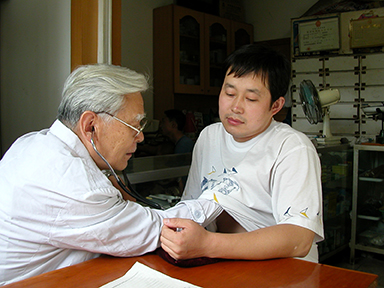
A consultation in a Cheng Du pharmacy
By Robert L. Felt, Co-author Understanding Acupuncture
The modern history of Chinese medicine is a history of interchange, the sometimes conflicting, sometimes conjoining meeting of Eastern and Western ideas. News of acupuncture and Chinese traditional medical practices arrived in Europe early in the Qing dynasty (1644 to 1911). There were already references to, and descriptions of, pulse diagnosis, acupuncture and moxibustion in Germany, Holland, and England by 1700. By 1718 it was already described as a remedy that had gone out of fashion. In 1755 the Dutch physician Gerhard van Swieten anticipated modern developments in acupuncture by nearly two centuries when he speculated that acupuncture and moxibustion were neurological phenomena. This idea was to appear again in 1798 when Rougement would label acumoxa treatment as “counter irritation therapy,” an idea that would resurface in Japan a century later.
In the West acupuncture was primarily used in the treatment of pain through methods that were void of traditional theories. The practice of traditional herbal medicine being essentially restricted to enclaves of native Chinese. The first and most common Western adaptation was needling pressure-sensitive points near a patient-reported pain. This method was first described in the 7th century by Sun Si-miao, who referred to these as a-shi (“it’s there” or “ouch”) points. Nineteenth century Western uses were neither fully traditional nor very broadly based. More importantly though, they clearly reflected the biases of the Western physicians who adopted acupuncture.
If Western physicians took too much for granted, Asians lost too much to circumstance. By 1912, acupuncture and moxibustion were in precipitous decline, barely able to counter the growth of biomedicine in Japan and China. In other East Asian countries, for example Vietnam, the same decline was also evident. In Europe and North America, acupuncture and moxibustion had gained a finger-hold, but were far from accepted. A few physicians had adopted a simplified form of acupuncture, but Soulie de Morant spent another decade in China before he returned with a vision of acupuncture that would take hold in Europe. Islands of traditional practice remained in Asia; but, as the world stood at the brink of the First World War, the traditional arts of acupuncture and moxibustion were close to cultural extinction.
In China the supports of traditional medicine had shattered. The failure of the traditional bureaucracy, the indifference of European powers, the abject poverty and misery of the population and the rapidly increasing influence of Western medicine, all contributed to its decimation. It met the 20th century as isolated and competing forms. In Japan, acupuncture was held hostage. With each successful modernization and industrialization, and with the growing therapeutic repertoire of biomedicine, it was restricted further.
In Europe, acupuncture was also in decline. It had a few strong supporters, and would resurge significantly only after George Soulie de Morant had spent 20 years tirelessly working against indifference and hostility. In North America acupuncture began this era as a footnote. A simplified form of acupuncture was recommended for low-back pain in Osler’s Principles and Practice of Medicine, but this endorsement apparently influenced few physicians. Fascinating stories have undoubtedly been lost by historical inattention to the lives of Chinese immigrants to the western USA. Among Americans of European descent, acupuncture was barely practiced at all until the 1970s.
Despite these unimpressive beginnings, the modern story of Chinese medicine is characterized by three primary phases:
- its resurrection from near extinction at the beginning of the 20th century;
- its hiatus and persecution through the Second World War; and
- its resurgence in East Asia and expansion throughout the West.
From its loss of place, its loss of social or political influence, it gained its freedom. Unfettered by now-defunct traditional forms and prejudices, and thought to be of little economic value, Chinese traditional medicine was carried forward only by those whose attachment was either to the art itself or to one of its practical applications. Orphaned by the old establishment, it was adopted and put to work. Because it did well, today, at the turn of the 21st century, it enjoys what may be its greatest popularity to date. An estimated 1 – 1.5 million people practice acupuncture across on the planet, and as many as a quarter of the Earth’s population has ready access to an acupuncturist.
